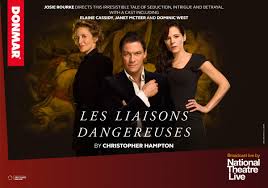
LES LIAISONS DANGEREUSES
UK, 2016, 180 minutes, Colour.
Dominic West, Janet Mc Ateer, Elaine Cassidy, Morfydd Clark, Edward Holcroft, Una Stubbs.
Directed by Josie Rourke.
This is a filmed version by the British National Theatre of a performance in the Donmar Warehouse, London in 2015-2016.
It is a revival of the play by Christopher Hampton, his adaptation of the 1782 French novel by Choderlos de Laclos. The play was first performed in the 1980s with great success in London’s West as well as on Broadway, a star vehicle for Alan Rickman and Lindsay Duncan. However, when a screen version was made in 1988, directed by Stephen Frears, the two stars were not so well-known and so the roles were taken by John Malkovich and Glenn Close. (Ironically, that same year, Alan Rickman appeared as the arch-villain in Die Hard which made his film career as well.)
Other films from the novel include a 1960s contemporary version with Gerard Philippe and Jeanne Moreau, a colourful period version, Valmont, with Colin Firth and Annette Bening, directed by Milos forman, 1990, and in 1999 a modern version with a younger cast, Cruel Intentions. In more recent times there has been a Chinese version.
The stage of the Donmar Warehouse is comparatively small and the audience is able to sit in front as well as on the two sides – and are sometimes visible during the filming. The set is quite elaborate, 18th-century classic – though with a touch of the faded gentility, by candles and chandeliers, with furniture of the period and, of course, beautiful costumes.
The central roles are taken by Dominic West and Janet Mc Teer, with Elaine Cassidy.
The play opens with the two central characters, former lovers, but now living quite amoral, immoral lives, involved in changing partners and seduction. The first scene has them plotting. Valmont has as his target a pious wife, Madame Tourvel, impervious to his attentions, her husband absent, and her being a good woman amidst this world of wealth, power, sexual exploitation. Madame de Merteuil is even more devious than Valmont, wanting revenge on a former suitor who has abandoned her and wants to make a more advantageous marriage, to young girl just out of her convent education. Madame wants Valmont to seduce her and then she will help him with his conquest.
Thus, the scene is set for this hothouse melodrama, the action of which takes place seven years before the French revolution – which some might consider did not come a moment too soon.
Other characters introduced are the young girl from the convent and her ambitious mother, formerly a courtesan but now very respectable, Valmont’s aunt (Una Stubbs) who entertains him and his target at her country estate, and a Chevalier who is infatuated with the young woman but gets entangled by Madame. There are various servants who connive at the action.
The main action of the film is Valmont’s courting of the young woman, her resistance, his persistence, her asking him to go away, his giving plausible reasons for returning, the emotional effect on her and her final succumbing to his seduction. And there is her final disillusionment as he breaks with her, even though he loves her. In the meantime, Madame continues on her way, exercising her wiles, exercising her wit, relishing her power, glad of the seduction of the young woman and her revenge, but entangling herself with the young Chevalier. Valmont, angry, challenges the Chevalier to a duel – to his death.
Dominic West struts the stage with quite some energy as Belmont, clever, charming, insinuating, but trying to resist his discovery of actual love. Janet Mc Teer is extraordinary in her impersonation of Madame, standing up for women, their domination, the control – a woman of power. At one stage towards the end, she is momentarily moved and sheds tear. In Stephen Frears’ film, at the end, Glenn Close as Madame is sitting at a mirror, removing her make up, reflecting, and a tear forms in the corner of her eye. In this version, Madame steels herself, looks out at the audience and determines that the competition will go on.
Well worth seeing in itself, but is interesting in its complementarity with the film version.